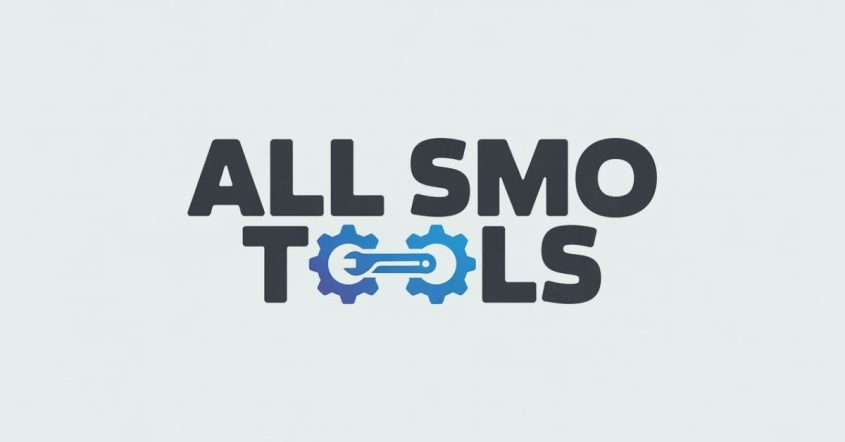Social Media Optimization (SMO) refers to a strategic approach to managing and enhancing your online presence through social media platforms. Unlike Search Engine Optimization (SEO), which focuses on improving visibility in search engine results, SMO is centered on maximizing your content’s reach and engagement on social media networks. It involves creating compelling content, engaging with followers, and using data-driven tools to refine performance.
In 2025, the digital landscape is more competitive than ever. Brands, influencers, and businesses must go beyond merely having accounts on platforms like Facebook, Instagram, LinkedIn, TikTok, and X (formerly Twitter). They need to be intentional about their strategy, consistent in their posting, and responsive to their audience. This is where SMO tools come into play—making it possible to manage these tasks efficiently and effectively. These tools help organize content, schedule updates, analyze performance, and foster stronger connections with audiences by automating repetitive tasks and providing actionable insights.
Why You Need SMO Tools
Handling multiple social media platforms manually can quickly become overwhelming, especially when trying to maintain consistency, track engagement, and respond to followers in real time. SMO tools simplify this process by consolidating everything into one streamlined interface.
One of the most significant advantages of using SMO tools is the ability to schedule posts ahead of time. This allows marketers and business owners to plan their content calendar in advance, maintain a steady posting rhythm, and ensure timely publication across various platforms. In turn, this boosts audience engagement and helps maintain relevance.
Another essential function is data analysis. These tools provide deep insights into audience behavior, such as what type of content performs best, the ideal times for posting, and which demographics engage most. Armed with this data, businesses can make informed decisions and refine their strategy for better results.
Core Functions of SMO Tools
SMO tools come equipped with a range of functions that support all aspects of social media management.
1. Content Planning & Scheduling
This is a foundational feature of nearly every SMO tool. It allows users to draft posts, set a publication schedule, and automatically push content to multiple platforms. With features like drag-and-drop calendars and AI-recommended times, these tools help maximize content visibility. Some platforms even allow content approval workflows to ensure quality and brand consistency in larger teams.
2. Visual and Copy Assistance
Content that grabs attention is crucial on social media. SMO tools often include integrations with design tools like Canva or offer built-in editors that allow users to create posts with eye-catching graphics, animations, and videos. AI-powered copy tools can generate captions, suggest hashtags, and check grammar or tone.
3. Engagement & Social Listening
This function lets you monitor mentions, comments, messages, and brand-related keywords in real-time. Social listening tools help understand audience sentiment and discover trending conversations relevant to your niche. It enables brands to respond quickly, manage reputation, and tailor future content to align with audience expectations.
4. Performance Analytics & Reporting
Most SMO tools include detailed analytics dashboards that track likes, shares, reach, clicks, engagement rate, follower growth, and more. Advanced tools offer cross-platform comparison, historical data, and customizable reporting templates to help businesses present findings to stakeholders clearly.
Together, these functions make SMO tools an essential part of a modern digital marketing toolkit, allowing for scalable, efficient, and data-informed social media management.
Top SMO Tools in 2025
The social media landscape in 2025 is filled with powerful tools designed to serve various user needs, from individuals to large enterprises.
Buffer is perfect for individuals and small businesses. Its user-friendly interface supports scheduling, publishing, and performance tracking. Buffer’s browser extension makes it easy to share articles on the fly, and its analytics help users understand post effectiveness and engagement trends.
Hootsuite is a comprehensive tool tailored for businesses managing multiple accounts and teams. It offers scheduling, team collaboration, monitoring, and powerful analytics. Hootsuite’s built-in content curation and approval workflows ensure smooth operations across large teams.
Social Champ is gaining popularity for its affordability and AI-powered features. It allows for bulk uploads, post recycling, and real-time content suggestions. Social Champ’s detailed analytics make it a strong choice for data-driven marketers.
SocialBee focuses on evergreen content management. Users can categorize posts (quotes, blog posts, promotions, etc.) and schedule each category differently. It also includes concierge services where experts help optimize your strategy.
On the visual creation side, Canva remains the top choice with its easy-to-use interface and extensive library of templates, fonts, and images. Whether it’s an Instagram story or a LinkedIn banner, Canva simplifies the design process.
Adobe Spark suits those needing advanced branding controls. It supports branded video creation, offers customizable templates, and is integrated with Adobe’s broader suite of professional tools.
Lumen5 turns long-form content into videos. Ideal for marketers wanting to repurpose blog posts or articles, Lumen5 uses AI to match visuals with text and generate short, engaging videos.
Sprout Social offers high-end features, including advanced analytics, CRM integration, and a Smart Inbox for managing messages. Its rich data visualization tools help in understanding customer behavior and planning long-term strategies.
BuzzSumo is excellent for trend discovery. It analyzes the most shared content across platforms, helps identify key influencers, and provides competitive insights—making it useful for content planning and influencer outreach.
Google Analytics (Social Reports) reveals how your social media contributes to website traffic and conversions. When paired with UTM tracking, it becomes a powerful way to measure ROI.
SEMrush combines SEO, content marketing, and social media in one platform. Its social media toolkit allows for post scheduling, performance monitoring, and competitor analysis across platforms.
YouScan monitors user-generated content and mentions using AI-driven visual recognition. It identifies logos, brand-related imagery, and customer posts even when untagged.
Nuvi excels in real-time social monitoring and data visualization. It’s particularly useful in managing brand reputation and crisis response.
Gremlin Social is tailored for regulated industries. It offers message approval systems, compliance tracking, and detailed audit trails to meet industry standards.
Free & Freemium SMO Tools
For those starting out or managing a small budget, many SMO tools offer free plans that still deliver strong performance.
Buffer (Free Plan): Allows three connected accounts and ten scheduled posts per account. Great for learning the basics of scheduling and analytics.
Later: Offers a free plan for one user per platform and 30 posts per month. It excels at Instagram scheduling with its drag-and-drop visual calendar.
TweetDeck: Completely free and ideal for real-time Twitter management. Users can track multiple timelines, hashtags, and interactions simultaneously.
Meta Business Suite: Enables Facebook and Instagram management, including post scheduling, messaging, and performance tracking. It’s free and integrated with Meta’s ad platform.
Phlanx: Known for its influencer marketing tools, including engagement rate calculators and collaboration opportunities.
Iconosquare (Free Audits): Offers limited access to analytics and audit tools to assess Instagram and Facebook performance.
These tools are perfect for individuals, freelancers, and small businesses looking to explore SMO strategies before scaling up.
How to Choose the Right SMO Tools
Selecting the best SMO tool requires clarity about your business goals, resources, and platform priorities.
Step 1: Identify Your Goals
Are you aiming to grow your audience, increase engagement, drive traffic to your website, or run social ad campaigns? Your goals will dictate the required features.
Step 2: Evaluate Budget and Team Size
Determine whether a free tool is sufficient or if you need premium features like multi-user access, workflow approvals, or CRM integrations. Larger teams need tools with robust collaboration features.
Step 3: Assess Platform Coverage
Make sure the tool supports all social networks you actively use. Some tools are strong on Instagram and Facebook but offer limited TikTok or LinkedIn support.
Step 4: Analyze Features and Usability
Choose a platform that balances powerful features with ease of use. A steep learning curve can slow down implementation.
Step 5: Check Integrations and Support
Confirm that the SMO tool integrates with your existing marketing stack (e.g., email marketing, analytics, CRM). Look for platforms with responsive customer support and active user communities.
By carefully matching features to your needs, you can select a tool that enhances efficiency and drives measurable results.
Best Practices for Using SMO Tools
To fully benefit from SMO tools, follow these actionable best practices:
- Set SMART Goals: Make sure your social media goals are Specific, Measurable, Achievable, Relevant, and Time-bound.
- Optimize for Platform Differences: Tailor content to suit each platform’s audience, format, and tone.
- Maintain a Consistent Brand Voice: Use templates and brand guidelines to keep visuals and messaging uniform.
- Post During Peak Times: Use data insights from tools to post when your audience is most active.
- Engage Daily: Make it a habit to respond to comments, answer queries, and thank followers. Real-time engagement builds community.
- Track and Analyze Metrics: Use analytics to evaluate post performance, adjust strategies, and report on KPIs.
- Test and Learn: Try different content types (images, polls, stories, reels), captions, and hashtags. Analyze what drives the best results.
- Stay Updated: Follow platform changes, new tool features, and industry trends to keep your strategy fresh and effective.
Future Trends in SMO Tools
Social media optimization is evolving, and the future promises even smarter, more intuitive tools.
AI-Driven Content Creation: Tools will increasingly use AI to recommend content ideas, generate captions, design visuals, and even create short-form videos.
Unified Marketing Dashboards: Expect more platforms to merge social, email, SEO, and paid marketing data into a single interface.
Visual Recognition & Listening: Tools like YouScan are paving the way for more advanced image-based brand monitoring across social media.
Voice and Audio Optimization: As podcasts and audio-based platforms grow, tools will help optimize soundbites, transcriptions, and distribution.
Augmented Reality (AR) Integration: Future tools may allow brands to test and preview AR filters, lenses, and other immersive content in real time.
Automation & Personalization: Tools will offer automated but personalized replies, DMs, and content scheduling based on user behavior.
Being early adopters of these technologies can give brands a competitive edge in visibility and engagement.
Conclusion
Social media optimization is no longer optional—it’s a vital component of any digital marketing strategy. As social platforms continue to evolve, staying ahead requires the right tools and a clear plan. From content planning and creation to monitoring and analytics, SMO tools empower you to manage your brand more effectively.
Whether you’re an individual creator or a large marketing team, there’s an SMO tool suited to your needs and budget. The key lies in choosing wisely, staying informed, and continuously improving your approach. By embracing the right SMO tools, you can boost your online presence, connect with your audience, and achieve sustained success in the digital world.
















